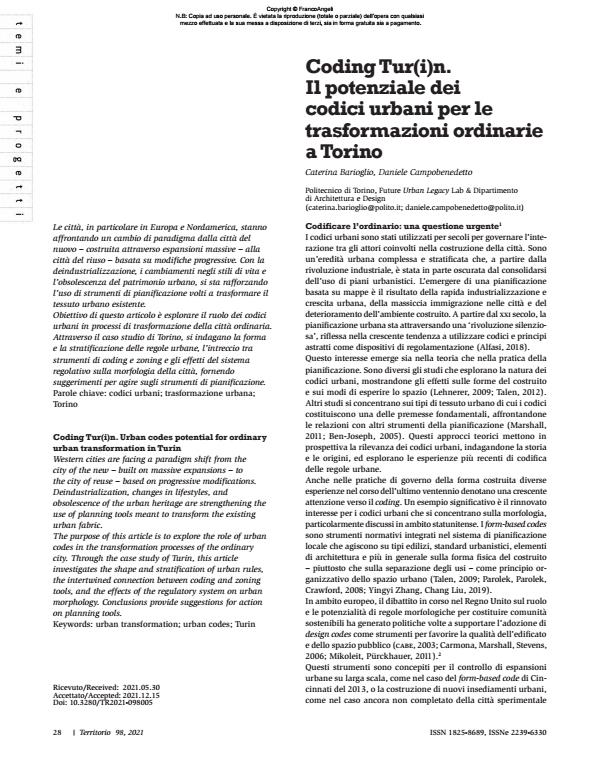Coding Tur(i)n. Urban codes potential for ordinary urban transformation in Turin
Journal title TERRITORIO
Author/s Caterina Barioglio, Daniele Campobenedetto
Publishing Year 2022 Issue 2021/98
Language Italian Pages 11 P. 28-38 File size 530 KB
DOI 10.3280/TR2021-098005
DOI is like a bar code for intellectual property: to have more infomation
click here
Below, you can see the article first page
If you want to buy this article in PDF format, you can do it, following the instructions to buy download credits

FrancoAngeli is member of Publishers International Linking Association, Inc (PILA), a not-for-profit association which run the CrossRef service enabling links to and from online scholarly content.
Western cities are facing a paradigm shift from the city of the new - built on massive expansions - to the city of reuse - based on progressive modifications. Deindustrialization, changes in lifestyles, and obsolescence of the urban heritage are strengthening the use of planning tools meant to transform the existing urban fabric. The purpose of this article is to explore the role of urban codes in the transformation processes of the ordinary city. Through the case study of Turin, this article investigates the shape and stratification of urban rules, the intertwined connection between coding and zoning tools, and the effects of the regulatory system on urban morphology. Conclusions provide suggestions for action on planning tools.
Keywords: urban transformation; urban codes; Turin
- Alfasi N., 2018, «The coding turn in urban planning: Could it remedy the essential drawbacks of planning?». Planning Theory, 17, 3: 375-395. DOI: 10.1177/1473095217716206
- Amin A., Graham S., 1997, «The Ordinary City». Transactions of the Institute of British Geographers, 22, 4: 411-442.
- Abramson D.M., 2016, Obsolescence: An architectural history. Chicago: University of Chicago Press.
- Bagnasco A., Berta G., Picchieri A., 2020, Chi ha fermato Torino? Torino: Einaudi.
- Barale M.F., 2019, Servitu di forma. Proprieta e regole urbane del costruire in una prospettiva comparata. Tesi di dottorato, Dottorato in Architettura Storia e Progetto, Politecnico di Torino.
- Barioglio C., Campobenedetto D., Nigra M., Barale M.F., Frassoldati, F., Robiglio M., 2019, Re-Coding. Ripensare le regole della citta. Torino: Politecnico di Torino. Batty M., 2013, The New Science of Cities. Cambridge-London: mit Press.
- Ben-Joseph E., 2005, The Code of the City. Cambridge-London: mit Press.
- Bertaud A., 2018, Order Without Design. How Markets Shape Cities. Cambridge-London: mit Press.
- Brenner N., 2019, New urban spaces: Urban theory and the scale question. Cambridge: Oxford University Press.
- cabe, 2003, The Use of Urban Design Codes. Building Sustainable Communities. London: Commission for Architecture and the Built Environment.
- Carmona M., Marshall S., Stevens Q., 2006, «Design codes: their use and potential». Progress in Planning, 65: 209-289.
- Cozzolino S., 2020, «The (anti) adaptive neighbourhoods. Embracing complexity and distribution of design control in the ordinary built environment». Environment and Planning B: Urban Analytics and City Science, 47, 2: 203-219. DOI: 10.1177/0956797619828724
- Dutton J.A., 2000, New American Urbanism: Re-forming the Suburban Metropolis. Milano: Skira.
- Habraken N.J., 2000, The Structure of the Ordinary. For and Control in the Built Environment, Cambridge-London: mit Press.
- Kostof S., 1991, The City Shaped. Urban Patterns and Meanings Through History. London: Thames and Hudson.
- Lehnerer A., 2009, Grand Urban Rules. Rotterdam: 010 Publishers.
- Marshall S., 2011, a cura di, Urban Coding and Planning. London-New York: Routledge.
- Mikoleit A., Pürckhauer M., 2011, Urban Code: 100 Lessons for Understanding the City. Cambridge-London: mit Press.
- Moroni S., 2015, «Complexity and the inherent limits of explanation and prediction: Urban codes for self-organising cities». Planning Theory, 14: 248-267. DOI: 10.1177/1473095214521104
- Moroni S., 2017, «Graphic rules in planning: A critical exploration of normative drawings starting from zoning maps and form-based codes». Planning Theory, 16, 3: 318-338. DOI: 10.1177/1473095216656389
- Moroni S., Buitelaar E., Sorel N., Cozzolino S., 2018, «Simple Planning Rules for Complex Urban Problems: Toward Legal Certainty for Spatial Flexibility». Journal of Planning Education and Research, 40: 320-331. DOI: 10.1177/0739456X18774122
- Panerai P., Castex J., Depaule J.C., 1997, Formes Urbaine. De l’ilot a la barre. Marsiglia: Éditions Parentheses.
- Parolek D.G., Parolek K., Crawford P.C., 2008, Form based codes: A guide for planners, urban designers, municipalities and developers. New York: Wiley.
- Roncayolo M., 2002, Lecture de villes. Formes et temps. Marsiglia: Éditions Parentheses.
- Rosner-Manor Y., Borghini S.G., Boonstra B., Silva P., 2020, «Adaptation of the Urban Codes–A story of Placemaking in Jerusalem». Environment and Planning B: Urban Analytics and City Science, 47, 2: 251-267. DOI: 10.1177/2399808319867712
- Talen E., 2009, «Design by the Rules. The historical underpinnings of form-based codes». Journal of the American Planning Association, 75, 2: 144-160. DOI: 10.1080/01944360802686662
- Talen E., 2012, City Rules: How Regulations Affect Urban Form. Washington-Covel-London: Island Press.
- Zhang Y., Liu C., 2019 «Parametric Modeling for Form-Based Planning in Dense Urban Environments». Sustainability, 11, 20: 5678.
Caterina Barioglio, Daniele Campobenedetto, Coding Tur(i)n. Il potenziale dei codici urbani per le trasformazioni ordinarie a Torino in "TERRITORIO" 98/2021, pp 28-38, DOI: 10.3280/TR2021-098005